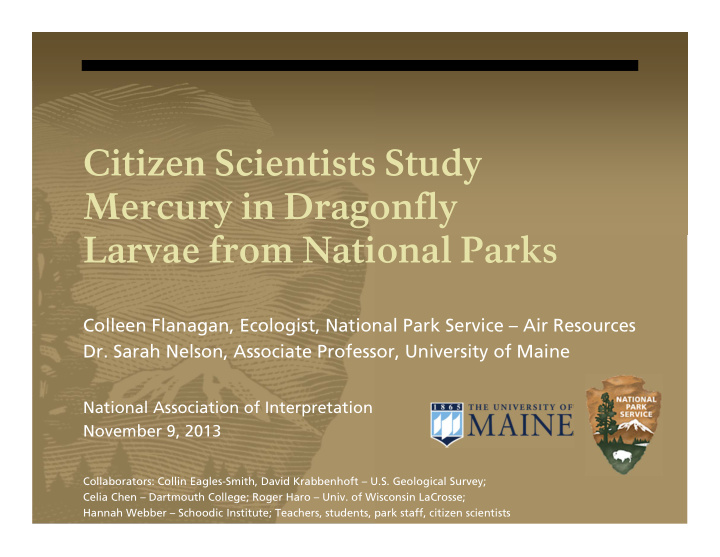



Citizen Scientists Study Mercury in Dragonfly Larvae from National Parks Colleen Flanagan, Ecologist, National Park Service – Air Resources Dr. Sarah Nelson, Associate Professor, University of Maine National Association of Interpretation November 9, 2013 Collaborators: Collin Eagles-Smith, David Krabbenhoft – U.S. Geological Survey; Celia Chen – Dartmouth College; Roger Haro – Univ. of Wisconsin LaCrosse; Hannah Webber – Schoodic Institute; Teachers, students, park staff, citizen scientists
The Dragonfly E X P E R I E N C E Y O U R A M E R I C A
Citizen Scientists
National Parks E X P E R I E N C E Y O U R A M E R I C A
Mercury E X P E R I E N C E Y O U R A M E R I C A
Hg – An Airborne Pollutant E X P E R I E N C E Y O U R A M E R I C A
Top 100 Mercury-Emitting Power Plants and Proximity to Class I National Parks
Mapping Mercury Sensitivity 2- + DOC + wetland % MeHg = pH + SO 4 Some ecosystems are more sensitive to mercury because certain environmental conditions are needed to convert mercury to the toxic methylmercury (MeHg). Abundant wetlands, low pH, high dissolved organic matter, and high sulfate are conducive to producing MeHg.
Why Mercury? Persistent Bioaccumulative Toxic Fish and other biota in national parks contain levels of mercury above human and wildlife health thresholds.
Why Dragonfly Larvae? Long-lived Biosentinels: Indicate ecosystem health Widespread Mercury in dragonfly Predatory larvae correlated to Important prey species mercury in fish & water Relatively easy to (Haro et al. 2013) collect
Methods Solicit Interest Sampling gear & 1. 3. shipping provided Parks selected 2. according to: ACTION! 4. Willingness to Collect a. participate Dragonfly larvae Potential mercury risk Water Samples Geographic location Identify to family b. Existing connection Measure length c. with citizen scientists, Send samples to d. including Research UMaine for Learning Centers analysis, QA/QC
Study…by the #’s • # parks 25 • # sites sampled 70 • # citizen scientists >300 • # volunteer hours ~1,000 • # dragonfly larvae collected 521 • # coolers shipped 30 • # pounds dry ice used 100 • # mm of biggest dragonfly larva 48 • # cups coffee consumed in the lab 35 Rocky Mountain National Park
2012 Data: Park-by-Park Mercury concentrations in dragonfly larvae are greatest at parks in the Eastern U.S. than the Western U.S. Median mercury (mean +/- SD) in larvae was 125 +/- 77 ppb, dw.
2012 Data: Site-by-Site Site differences within a park reveal that dragonfly larvae can describe fine-scale differences in Hg risk. Median Hg highest at Lily Lake, Turner River, and Great Pond.
Hear ye, Hear ye Webpage Facebook Six-Legged Scouts in Call for Interest the National Parks Webinars “Like” us! Videos Sampling demo Tutorial on identification to family Podcast by Great Smoky Mtns NP
Interpretive Opportunities i.e., how you can Develop programs with park rangers, e.g., get Standards-based lessons involved Teacher-Peer workshops and materials Menu of education offerings Some parks have already developed great activities! Foster continued engagement with data Sign up! Participate! We need more parks! Align with Bioblitz and Biodiversity Discovery activities in the national parks Improve ability to identify samples, possibly through an App Connect with USGS Community for Data Integration (CDI) Citizen Science Group E X P E R I E N C E Y O U R A M E R I C A
Clean Hands, Dirty Hands “A Fun Activity to Demonstrate Proper Sample Handling Techniques or How Swedish Fish Can Contribute to Citizen Science” Contributor: Andrea Blakesley, Denali NP&P E X P E R I E N C E Y O U R A M E R I C A
Take Home Messages Back Front E X P E R I E N C E Y O U R A M E R I C A
"Through interpretation, understanding, through understanding, appreciation, through appreciation, protection." -Freeman Tilden COMMUNICATING SCIENCE E X P E R I E N C E Y O U R A M E R I C A
Merging science and education to preserve and protect areas of national significance. PARTICIPATORY SCIENCE E X P E R I E N C E Y O U R A M E R I C A
Win, Win Citizen scientists- Further supported by A Call to Action Gain new perspectives Connecting People to Parks Practice civic skills Advancing the Utilize parks as Education Mission outdoor laboratories NPS- Foster teachable moments Save project dollars
National Park Service University of Maine Air Resources Division Mitchell Center Colleen Flanagan colleen_flanagan@nps.gov Dr. Sarah Nelson sarah.j.nelson@maine.edu Project Webpage http://www.nature.nps.gov/air/Studies/air_toxics/dragonfly/index.cfm
Recommend
More recommend